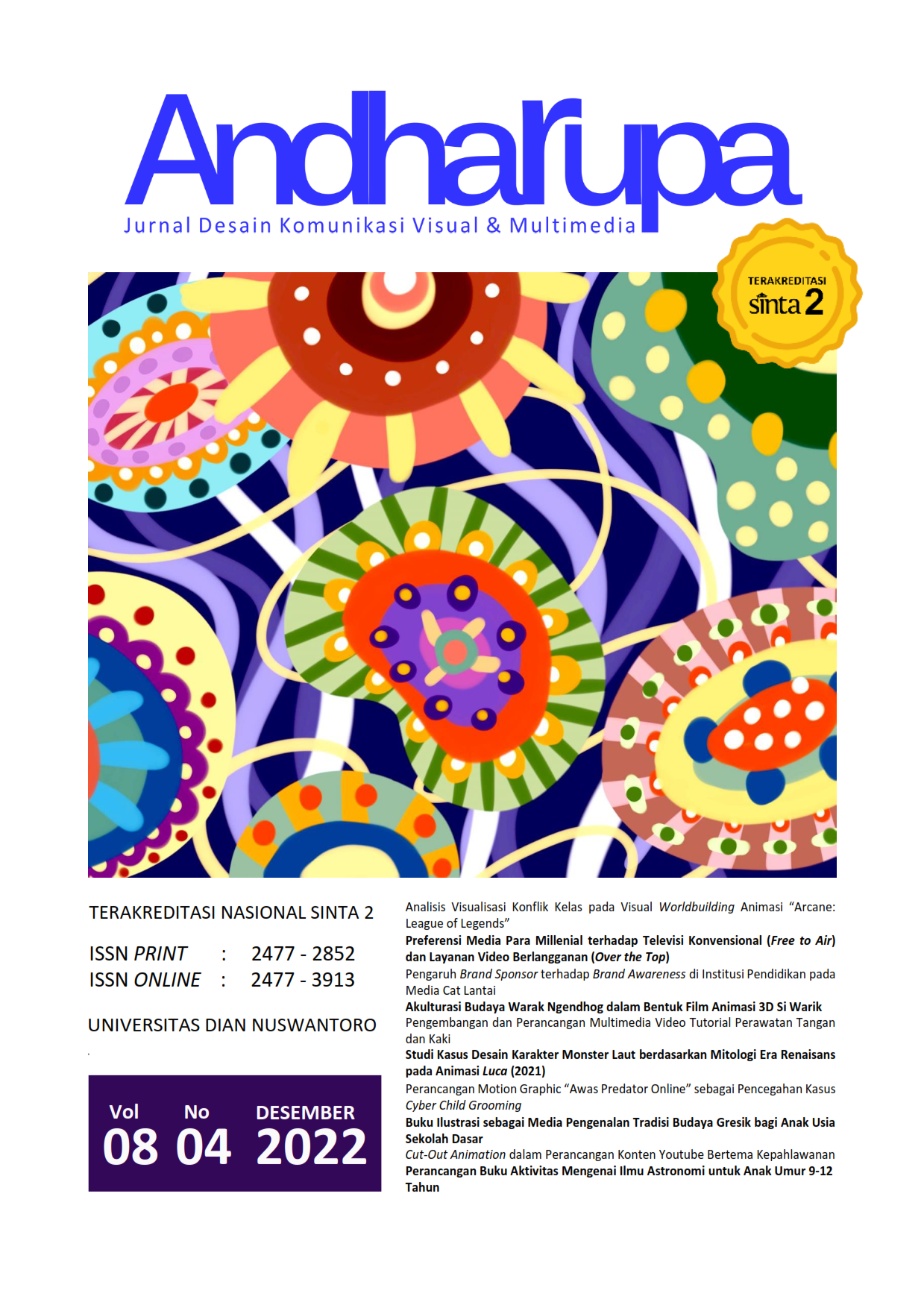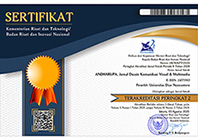Preferensi Media Para Millenial terhadap Televisi Konvensional (Free To Air) dan Layanan Video Berlangganan (Over The Top)
DOI:
https://doi.org/10.33633/andharupa.v8i04.6845Abstract
AbstrakPara milenial memiliki ketergantungan terhadap gadget dan internet dalam memilih media hiburan. Televisi konvensional (free to air) yang berjaya selama puluhan tahun, harus bersaing dengan berbagai media untuk merebut hati para milenial. Salah satunya adalah layanan over-the-top atau konten video berlangganan melalui jaringan internet. Amazon Prime Video, Catchplay, Iflix, Mola TV, Netflix, Vidio, VIU, Disney+Hotstar, RCTI+, WeTV, dan Vision+ adalah contoh platform over-the-top yang ada di Indonesia. Penelitian ini bertujuan untuk mengetahui perubahan konsumsi media televisi dengan keberadaan over-the-top di kalangan milenial. Penelitian ini dilakukan dengan metode kualitatif deskriptif. Pengumpulan data dilakukan melalui wawancara dan studi literatur. Analisis data dilakukan dengan melakukan kondensasi data, penyajian data, penarikan kesimpulan dan verifikasi. Hasil penelitian menunjukkan terjadinya pergeseran pola konsumsi media di kalangan milenial. Over-the-top memberikan kepuasan dari sisi fleksibilitas, ketiadaan gangguan commercial break dan ragam tayangan yang dapat dipilih. Namun, over-the-top memunculkan ketidakpuasan karena biaya berlangganan yang dikenakan dan jaringan internet yang tidak memadai. Kata Kunci: analisis audiens, milenial, over-the top, preferensi media, televisi AbstractMillennials depend on gadgets and the internet to choose entertainment media. Conventional television (free-to-air) which has triumphed for decades, must compete with various media to attract the millennials. One of them is over-the-top or subscription video content through the internet. Amazon Prime Video, Catchplay, Iflix, Mola TV, Netflix, Vidio, VIU, Disney+Hotstar, RCTI+, WeTV, and Vision+ are examples of over-the-top platforms in Indonesia. This research aims to find out changes in television media consumption with the existence of over-the-top among millennials. This research was conducted using a qualitative descriptive method. Data collection was conducted through interviews and literature studies. Data analysis was carried out by data condensation, data display, conclusion drawing and verification. The results showed a shift in media consumption patterns among millennials. Over-the-top provides satisfaction in terms of flexibility, the absence of commercial breaks, and the variety of shows. However, over-the-top raises dissatisfaction due to subscription charges and the inadequate of internet connection. Keywords: audience analysis, millennials, media preferences, over-the top, televisionReferences
Abdullah. (2018). Daya Saing Ott (Over the Top) E-Commerce Indonesia Dalam Menghadapi Persaingan Global. LABATILA: Jurnal Ilmu Ekonomi Islam, 2(1), 26–52.
Adhrianti, L. (2008). Idealisasi TVRI sebagai TV Publik: Studi “Critical Political Economy.” MediaTor, 9(2), 281–292.
Afiftania, L. A., Mahmudah, N., & Putri, F. H. (2021). Diferensiasi Hukum bagi Penyedia Layanan Over The Top (Studi Perbandingan Indonesia dengan Singapura). Perspektif Hukum, Vol. 21(1), 81.
Agatha, A. R., & Hadjon, E. T. L. (2020). URGENSI PENGAWASAN LAYANAN KONTEN DIGITAL OVER THE TOP (OTT) DI INDONESIA. Jurnal Kertha Negara, 8(12).
Ansory, W. A., Widiyanti, I. D., & Kumalasari, N. (2019). Companies in Investment Activities of Indonesia. Lentera Hukum, 13(1), 189–202.
Astuti, D. (2020). Kilas Balik Sejarah Televisi Indonesia. Goodnews from Indonesia. https://www.goodnewsfromindonesia.id/2020/01/23/kilas-balik-sejarah-televisi-indonesia
Audinovic, V. (2021). Eksistensi Televisi Swasta di Era Konvergensi Media The Existence of Private Television in Convergence Media Era. Jurnal Spektrum Komunikasi, 9(2).
Bjelica, M., Rikalovic, D., & Ilkic, V. (2016). Minimizing impact of loading time and presentation to user experience in modern Over the Top television. 2015 IEEE 5th International Conference on Consumer Electronics.
Bohang, F. K. (2016). Akhirnya Masuk Indonesia, Netflix Itu Apa? Kompas.Com.
BPS. (2021). Hasil Sensus Penduduk 2020.
Cahyadini, A., Muttaqin, Z., Dewi, S., & Sugiharti, D. K. (2022). Pajak Penghasilan Bagi Over-the-Top di Indonesia. Jurnal Ilmu Hukum Veritas et Justitia, 8, 171–190.
Camilleri, M. A., & Falzon, L. (2021). Understanding motivations to use online streaming services: integrating the technology acceptance model (TAM) and the uses and gratifications theory (UGT). Spanish Journal of Marketing - ESIC, 25(2), 217–238.
Dhiman, N., Singh, A., & Sarmah, R. (2022). How Continuous Intentions Towards Over the Top Platform are Framed? Stimulus–Organism–Response Model Perspective. Vision: Journal of Business Perspective.
ssa, V. V. (2017). Perlindungan Hukum Data Pribadi Pengguna Layanan Over the Top Communication Services di Indonesia. Universitas Airlangga.
Diza, N. (2022). Perlindungan Hukum terhadap Karya Cipta pada Layanan Over-the-Top (OTT). Technology and Economics Law Journal, 1(1).
Djairan. (2021). Resmi! MNC Vision & MNC Play Luncurkan Layanan Selfcare di Aplikasi Vision+. Inews.Id. https://www.inews.id/finance/bisnis/resmi-mnc-vision-mnc-play-luncurkan-layanan-selfcare-di-aplikasi-vision
Elias, J. (2019). From Pay-TV to Streaming Platforms: The influence of Decision-making-power and Age on consumers’ motivations. 1–83.
Fauzan, R. (2019). Layanan OTT Geser Industri Film Tanah Air. Bisnis.Com. https://teknologi.bisnis.com/read/20190412/84/910928/layanan-ott-geser-industri-film-tanah-air
Fernanda, M. R., & Hasbi, I. (2021). Determinan Faktor Pembentuk Preferensi Konsumen pada Pengguna Disney+ Hotstar di Indonesia (Studi pada Pengguna Disney+ Hotstar di Indonesia). E-Proceeding of Management, 8(4), 3378–3386.
Gaikwad, V., & Rake, R. (2021). Indonesia Over-The-Top (OTT) Market. Allied Market Research. https://www.alliedmarketresearch.com/indonesia-over-the-top-market
Griffin, E., Ledbetter, A., & Sparks, G. (2019). A First Look at Communication Theory (10th ed.). McGraw-Hill Education.
Gultom, A. D. (2020). Synergy of Over the Top Services Operation and Telecommunication Operators in Indonesia. Jurnal Penelitian Pos Dan Informatika, 10(2), 81.
Haqqu, R. (2020). Era Baru Televisi dalam Pandangan Konvergensi Media. Rekam, 16(1), 15–20.
Heresco, A., & Figueroa, S. (2020). Over the Top: Retransmission Fees and New Commodities in the U.S. Television Industry. 29(1), 19–45.
Jemadu, L. (2022). NET TV Segera Hadirkan OTT Netverse. Suara.Com.
Jenita, N. S. (2021). Pengaruh Lifestyle, Electronic Word Of Mouth, dan Brand Image Terhadap Willingness To Subscribe Pada Layanan Over The Top Netflix (Studi Pada Pengguna Netflix). Jurnal Ilmiah Mahasiswa FEB, 9(2), 37–72.
Karimuddin, A. (2016). Bukan HOOQ dan iflix, Netflix Lebih Dulu Masuk Indonesia. DailySocial. https://dailysocial.id/post/netflix-indonesia
Littlejohn, S. et. a. (2017). Theories of Human Communication (11th ed.). Waveland Press, Inc.
Maizal Walfajri. (2017). Video streaming Viu kian ekspansif di Indonesia. Kontan.Co.Id.
Malewar, S., & Bajaj, S. (2020). Acceptance of OTT video streaming platforms in India during covid -19: Extending UTAUT2 with content availability. Journal of Content, Community and Communication, 12, 89–106.
Manggalani, R. U., & Prastya, D. (2021). Kominfo Ungkap Layanan OTT Jadi Tantangan Baru Media Konvensional. Suara.Com. https://www.suara.com/tekno/2021/10/17/175041/kominfo-ungkap-layanan-ott-jadi-tantangan-baru-media-konvensional
McKinley, J. (2018). Are online streaming services hurting traditional television and radio ? Uloop Inc.
Menon, D. (2022). Purchase and continuation intentions of over -the -top (OTT) video streaming platform subscriptions: a uses and gratification theory perspective. Telematics and Informatics Reports, 5(June 2021), 100006.
Miles, M. B., Huberman, M., & Saldana, J. (2014). Qualitative Data Analysis: a Method Sourcebook (3rd ed). SAGE Publications.
Mustika, R. (2012). Budaya Penyiaran Televisi di Indonesia. Masyarakat Telematika Dan Informasi Volume, 3(1), 51–56.
Nabilah, Z. A. (2020). Incorrect Regulation Limiting Space of Movement, Communication Policy Regulation Dilemma Against the Application of Over-the-Top in Indonesia. 2nd Jogjakarta Communication Conference (JCC 2020).
Nielsen. (2020). Covid-19 dan Dampaknya pada Tren Konsumsi Media. Nielsen.Com. https://www.nielsen.com/id/news-center/2020/covid-19-dan-dampaknya-pada-tren-konsumsi-media/
Nugraha, S. H., & Jumhur, H. M. (2016). Analisis Model Bisnis Over-The-Top (OTT) Services Berdasarkan Sudut Pandang Operator Telekomunikasi Bergerak Seluler di Indonesia sebagai Bentuk Pertimbangan Regulasi (Studi Pada PT.XL Axiata, TBK). E-Proceeding of Management, 3(1), 48–54.
Parrot Analytics. (2021). Indonesia streaming television market share Q3 2021 for Netflix, Disney+ Hotstar, Amazon Prime Video, HBO Max, Apple TV+ and more. Parrotanalytics.Com. https://www.parrotanalytics.com/insights/streaming-wars-who-is-winning-indonesia-q3-2021/
Pawito. (2007). Penelitian Komunikasi Kualitatif (Aindoble (ed.); 1st ed.). LKiS Yogyakarta.
Polit, D., & Beck, C. (2004). Nursing research: Principle and methods (7th ed.). J.B. Lippincott Company.
Prasetyo, D., & Purwanto, B. (2019). Strategi Bisnis PT. Telekomunikasi Selular Hingga Tahun 2021 dalam Menghadapi Masuknya Layanan Over the Top pada Industri Telekomunikasi di Indonesia. Universitas Gadjah Mada.
Ramli, T. S., Ramli, A. M., Budhijanto, D., Permata, R. R., Adolf, H., Damian, E., & Palar, M. R. A. (2019). Prinsip-prinsip Cyber law Pada Media Over The Top E-Commerce Berdasarkan Transformasi Digital Di Indonesia. Prinsip-Prinsip Cyber Law Pada Media Over The Top E-Commerce Berdasarkan Transformasi Digital Di Indonesia, 16(3), 392–398.
Sadana, M., & Sharma, D. (2020). How over-the-top (OTT) platforms engage young consumers over traditional pay television service? An analysis of changing consumer preferences and gamification. Young Consumers, 22(3), 348–367.
Safiranita, T., Muttaqin, Z., Sukarsa, D. E., Cahyadini, A., & Putri, S. A. (2021). The Role of Over-theTop (OTT) Service of Utilization of Telecommunication Infrastructure Based on Indonesia Tax and Non-Tax Policy. Journal of Southwest Jiaotong University, 56(5), 67–79.
Sanityastuti, M. S. (2007). “Membaca” Televisi Indonesia, Sebuah Upaya Menyikapi Tayangan Televisi. Jurnal Komunikasi, 2(1), 189–200.
Sari, S. P. (2019). Luncurkan Layanan Streaming RCTI+ di HUT ke-30 RCTI, HT: Terus Jadi Trendsetter. Inews.Id.
Setyani, E. P. (2016). Layanan Streaming Film iFlix Siap Bersaing dengan Netflix di Indonesia. Id.Techinasia.Com.
Sihombing, A. K., Permata, R. R., & Ramli, T. S. (2021a). Comparison of Digital Copyright Protection on Over the Top ( OTT ) Streaming Content Media in Indonesia and the United States Perbandingan Perlindungan Hak Cipta Digital pada Media Over The Top ( OTT ) Streaming Content di Indonesia dan Amerika Serikat A . 183–212.
Sihombing, A. K., Permata, R. R., & Ramli, T. S. (2021b). Comparison of Digital Copyright Protection on Over the Top (OTT) Streaming Content Media in Indonesia and the United States. Padjadjaran Jurnal Ilmu Hukum, 8(2).
Silaban, A. D., Amirulloh, M., & Rafianti, L. (2020). Podcast : Penyiaran Atau Layanan Konten Audio Melalui Internet (Over the Top) Berdasarkan Hukum Positif di Indonesia. Jurnal Legalitas, 13(02), 129–143.
Silfiani, D. (2022). Juridical Review on Collection and Distribution of Royalties for the Use of Copyrights of Song and/or Music on Over-The-Top Services in Indonesia. Budapest International Research and Critics Institute-Journal (BIRCI-Journal, 5(1), 2615–1715.
Simanjuntak, B. N. (2022). Konvensional dan Penyediaan Layanan Aplikasi dan / atau Konten melalui Internet Over-the-Top dalam Perpektif Persaingan Usaha yang Adil. 1(July).
Singh, N., Arora, S., & Kapur, B. (2022). Trends in over the top (OTT) research: a bibliometric analysis. VINE Journal of Information and Knowledge Management Systems.
Suhartadi, I. (2020). COVID-19 Mempercepat Adopsi Layanan Over The Top di Indonesia. Investor.Id. https://investor.id/it-and-telecommunication/229665/covid19-mempercepat-adopsi-layanan-over-the-top-di-indonesia
Taherdoost, H. (2018). A review of technology acceptance and adoption models and theories. Procedia Manufacturing, 22, 960–967.
The Trade Desk. (2020). 57 Percent of Southeast Asian Viewers are Now Streaming More OTT Video Content Because of COVID-19, According to New Research from The Trade Desk. The Trade Desk. https://investors.thetradedesk.com/news-releases/news-release-details/57-percent-southeast-asian-viewers-are-now-streaming-more-ott/
Tiara, B. R. A., Putra Arta L, D., Bunga B, G., Muasaroh D, K., Nur K, L., Ayu C, P., & Rahmi, V. (2021). Dominasi YouTube, WhatsApp dan Facebook di Indonesia : Potensi Ancaman Layanan OOT (Over-The-Top) Asing Terhadap Kedaulatan Negara. Review of International Relations, 3, 79–94.
Udoakpan, N., & Tengeh, R. K. (2020). The impact of over-the-top television services on pay-television subscription services in south africa. Journal of Open Innovation: Technology, Market, and Complexity, 6(4), 1–28.
Wardani, A. S. (2019). Vidio Targetkan 30 Juta Pengguna Aktif pada 2019. Liputan6.Com. https://www.liputan6.com/tekno/read/3924056/vidio-targetkan-30-juta-pengguna-aktif-pada-2019
Wibisono, G., Fithria, N., & Nugroho, C. (2018). Analysis of Cooperation Policy Between Over the Top Internet Video Service Provider with Telecommunication Operator in Indonesia. 4th International Conference on Nano Electronics Research and Education (ICNERE).
Yosuadi, D. (2021). Problematika Prinsip Net Neutrality Berkenaan Layanan Jasa Netflix Pada Regulasi Nasional Indonesia. Jurnal Ilmu Hukum, 07(1), 1–21.
Zinnia Valentine, L. (2018). Analisis Perspektif Regulasi Over The Top Di Indonesia Dengan Pendekatan Regulatory Impact Analysis. Jurnal Telekomunikasi Dan Komputer, 8(3), 222–232.
Downloads
Published
Issue
Section
License
Authors who publish with this journal agree to the following terms:
- Authors retain copyright and grant the journal right of first publication with the work simultaneously licensed under a Creative Commons Attribution License that allows others to share the work with an acknowledgment of the work's authorship and initial publication in this journal.
- Authors are able to enter into separate, additional contractual arrangements for the non-exclusive distribution of the journal's published version of the work (e.g., post it to an institutional repository or publish it in a book), with an acknowledgment of its initial publication in this journal.
- Authors are permitted and encouraged to post their work online (e.g., in institutional repositories or on their website) prior to and during the submission process, as it can lead to productive exchanges, as well as earlier and greater citation of published work (See The Effect of Open Access).















